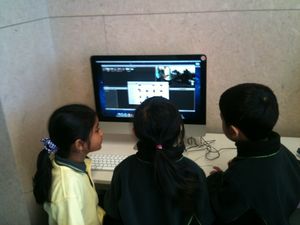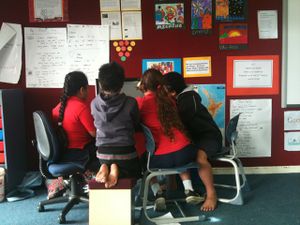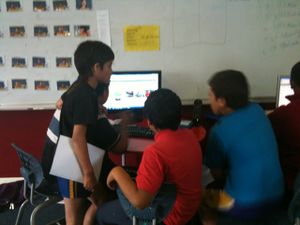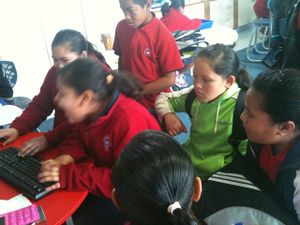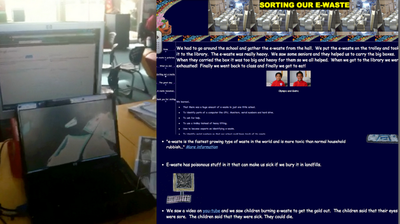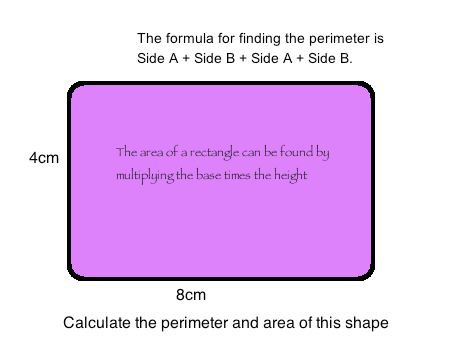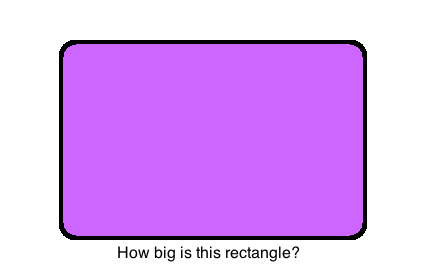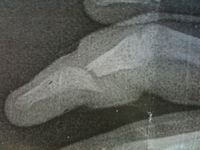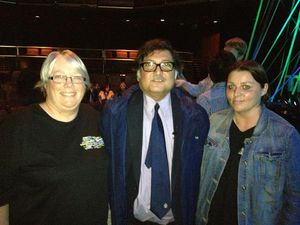Minimally invasive education
|
edit
Minimally Invasive EducationFile:Sugata Mitra at 2010 Online Educa.jpg Sugata Mitra at 2010 Online Educa
Sugata Mitra has been awarded the TED prize. Check out the latest details hereHow children learn in unsupervised environments
The findings of particular interest to me, are that the children taught themselves English so that they could use search engines. He also argues that they improved their English pronunciation on their own. As a teacher in a school with a predominant Pasifika roll, I wondered if I could use this emerging pedagogy to improve the oral language skills of my students. I had already been playing around with the use of video technology (as a part of my 2010 eFellowship research). Here I used the magic of video to enable children to self reflect and improve upon their spoken language. As a result of this research I also discovered that the use of cameras in the classroom can enable children to reflect on their group participation skills. This meshes very well with Dr Mitras research in that he also focuses on the importance of social interaction skills and value systems.
| |
|
edit
The importance of SOLEs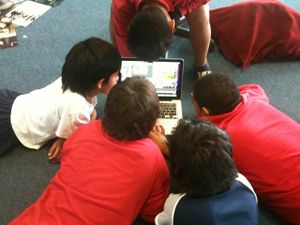 Rugby Boys Edit World Cup ad in a SOLE. Watch their ad here video
SOLEs (Self Organized Learning Environments) have been built my Sugata Mitra to achieve MIE. These environments enable children to sit in front of large screens with fast broadband. Furniture needs to be arranged so that children can sit in groups. The discussion between children is a crucial ingredient of MIE. This TED Talk illustrates the remarkable self-learning that can take place in this kind of environment. While the average classroom cannot achieve the fabulous learning spaces seen in this video, consider spreading your computers around the classroom so that children can learn around computers in small groups (as opposed to having all computers in one area). If you are in a 1:1 setting ensure that children are still organised in groups so that they can discuss and share what they are learning. Mobile devices such as smartphones and capacitive touch screen tablets are great for this because they allow the learners to easily share and view their devices in small learning groups. The pictures below illustrate that this small group self-learning can be achieved easily with both desktop computers and laptops also. Another great point that came out of this interview was our obsession that learners use the correct vocabulary (preferably in English) otherwise how will we know that they are learning? Mitra points to a wonderful example where the New Deli children used metaphors and made connections from their own lives to explain the 'mouse' and 'hourglass' on our western assembled machines.
Patricia Ryan also discusses the dangers of this Insistence on English in this Ted Talk 5 year olds, iMovie and MIEMay 2012 Remoteness was first addressed by Mitra in a geographical sense. For example (in the context of Delhi) he found that the further schools are from the city, the lower the educational outcomes. He then went on to discover that remoteness was not just a developing nation problem but happening in all countries across the globe. Even in developed nations there continues to be areas where there are clusters of 'under-achievement'. When it comes to access to, and knowledge of, digital resources this is often referred to as The Digital Divide. Like remoteness, the digital divide can lurk anywhere. It is often assumed that the higher the decile, ranking the more access children have to knowledge and digital literacies. However this is an incorrect assumption - there are many cases where children in decile 10 schools can have very limited access to eLearning and, at the same time, many decile 1 schools have exceptional eLearning programmes and opportunities. It can also be the case that there are digital divides within schools. For example, there are many teachers who bring old devices in from home, encourage students to use their personal eLearning devices (often their smartphones), beg borrow and acquire older computers from wherever they can, and basically do anything they possibly can to increase the computer to student ratio. Yet, in the class next door, there could well be only one classroom computer sitting on the teachers desk while their Tela laptop remains at home and is lucky if it is used once a week for facebook and trademe. Just as Sugata Mitra has said, the most important factor to increasing learning is very much down to the individual teacher. Too often a student's digital literacy experience is limited by what their teacher can do. How often do we hear "I can't do eLearning unless I get adequate PD first". Enter Minimally Invasive Education. Today a couple of exceptional junior school teachers and myself pooled all our iMacs together to see if we could encourage our 5 year-olds to gather in SOLES (Self-Organised Learning Environments) and teach themselves how to use iMovie. Within less than an hour they were creating projects, dragging photos into iMovie, adding sound effects, adding titles, adding transitions, and recording their own voice-overs. They were self-teaching, they were exploring, they were empowered. The topic of their inquiry this term is Beauty and Joy. As an outsider looking in I was overjoyed and it certainly was a beautiful thing! edit
Learning about Argentina in a SOLE in 20 minutesThis term, like many New Zealand Primary School classes, my class is learning about the Rugby World Cup. Areas within NZ have been allocated countries to study. Our country is Argentina. Given that I know very little about Argentina, I thought that this would be a fantastic opportunity to 'try out' Sugata Mitra's SOLES in the way he referred to it in this talk when he went to Turin, Italy (you can view this at 14:19). So following the Mitra recipe, the children self grouped themselves in groups of 4. They were told that they were able to wander around the room, and take other group's ideas back to their own groups. They were asked to find out information about Argentina. After 20 minutes they reported back to the whole class. In 20 minutes they:
Sugata Mitra argues that children can teach themselves English in SOLES. To test this theory in a NZ context I have challenged my children to teach themselves Spanish in 6 weeks. Their mission is to create a movie for a school in Argentina. The tricky part is that they are only to use the Spanish Language.
Friday 1 (11 August 2011) Friday 2 (18 August 2011) MIE does not have to be confined to ICT alone. One of my students was discussing the Spanish project with his SLS teacher and discovered that she spoke Spanish too. She listened to his "Hello my name is ..." and gave him some pointers re sentence structure. It would be more correct to use: "I am called..." This highlights the importance of children interacting with 'experts' rather than just their classroom teacher. Again emphasizing the importance of the 'Granny Cloud' and the shifting role of the teacher. After 6 weeks the students were certainly not fluent in Spanish, however they are aware of basic differences in sentence structures. They have picked up a variety of Vocab words and have cut a film for an Argentina class which is awaiting voice over. Interestingly the children were more concerned with the social aspects of Argentina rather than the language. Their main interest was whether or not kids from Argentina were rich or poor and what kind of sports they played. They very much enjoyed hearing their name used in spanish sentences. For me, this highlights the importance of using our technology to connect our students with 'real-life' perspectives and contacts (e.g video-conferencing an actual classroom rather than relying on adult-made tools). Again, our role as teachers is changing! edit
The Changing Role of the TeacherAt Educamp Aucklandsome like-minded educators and I discussed how tragic it would have been if I had planned a 'unit' that spanned an entire term where children had to sit through me telling them what they were all able to access and recall in a mere 20 minutes. Several similar anecdotes were shared in this forum. We discussed how this is a fine demonstration of how our role as teachers MUST change. In this context, my role is to find connections and more authentic learning about Argentina. My mission is to connect my kids with a school from Argentina using video conferencing and movie making. I will not be wasting my student's time by 'teaching' them banal content knowledge and 'facts' about Argentina. This is quite simply because (as the late Arthur C Clarke said to Sugata Mitra):
In a business week online briefing Mitra is careful to point out that his findings do not show that teachers can be replaced by machines. However, our role is dramatically changing:
Later in the interview he goes on to say:
When we bring these two points together it is chilling stuff with implications for all of our learners. As educators we need to stop wasting our children's precious time and money with formalised "computer science" teaching. Such as:
edit
Minimally Invasive ContentMIE - Minimally Invasive Content -We had a wonderful experience at the end of this year achieving a successful MIE experience where the children delivered and drove the curriculum for two weeks! Term 4 has always been a mad time of year for my Year 5-6 class. We have so many prescribed activities that it is always difficult to start long-term meaningful activities without constant interruption for various (and very necessary) whole-school activities (sports, cultural performance, graduation dance, and prizegiving). Our blog posts and movie making began to get few and far between and this was not helped by a spate of three robberies in a row. By the end of the year we had only my laptop and 3 old desktops that I had acquired from the storage room in the library. Meanwhile, I had had the absolute privilege of being a part of the Emerging Leaders Symposium where we met once a term to share ignite talks. One such ignite talk was Mark Osborne's talk on Un-Conferences for teacher PD. So a colleague Tim Kongand I decided to have an Un-Conference in our classrooms. All the practices were coming to an end, I had no ICT gear, the art supplies were dismal, and quite frankly the year 6s were pretty much 'over' their primary school experience. What did I have to lose? The process went basically like any other Un-Conference: A short time to prepare what workshop you would like to teach.
Heads snapped around from all corners of the classroom after that discussion and things started to hum. The curriculum for that week was something I could have never imagined:
The 'tutors' wrote their work-shop up on a post-it and the kids opted in and out of what they wanted to do. Just like the adult conferences there was some angst when a 'tutor' was teaching at the same time a session they wanted to attend was running so there were many requests for repeat lessons. The Taiaha lesson was so popular that the 'tutor' was running sessions during playtime and children from other classes were signing up. I was stunned by the Maturity and Mana of our Taiaha tutor who insisted on correct Tikanga (removing student's hats and shoes as well as telling stories about feathers dropping, chiefs and other meaningful knowledges). I learned so much! Tim and I connected our classes with a skype call and shared google forms. The adapted Granny Cloud worked nicely where his (slightly older) students modeled some great reflection of the process which my students gained from immensely. Student's Reflections Here are a couple of short vids of the process but it really doesn't give it justice. There was just so much good things happening - I found I had to put the camera down and enjoy the experience. |
edit
Arithmetic - we have to change our thinking
In his book Beyond the Hole in the Wall Mitra makes the alarming point about the future of maths education.
Not many educators would argue that our role continues to be one where will fill our empty vessels with knowledge, yet a high proportion of our maths education seems to continue to be just that. Conrad Wolfram puts it beautifully in this Ted talk. He breaks down maths education into 4 parts:
He then suggests that we stop wasting 80% of our students time on Step 3 (calculation) and instead use computers for this. This means that our students can spend more time on the more important steps (1, 2 and 4) Wolfram argues: People confuse ... the order of the invention of the tools with the order in which they should use them for teaching. So just because paper was invented before computers, it doesn't necessarily mean you get more to the basics of the subject by using paper instead of a computer to teach mathematics. He goes on to further argue: it's very important to get computers in exams. And then we can ask questions, real questions, questions like, what's the best life insurance policy to get? -- real questions that people have in their everyday lives. And you see, this isn't some dumbed-down model here. This is an actual model where we can be asked to optimize what happens Then he leaves us with a challenge: So I want to see a completely renewed, changed math curriculum built from the ground up, based on computers being there, computers that are now ubiquitous almost. Calculating machines are everywhere and will be completely everywhere in a small number of years. Now I'm not even sure if we should brand the subject as math, but what I am sure is it's the mainstream subject of the future. Let's go for it, and while we're about it, let's have a bit of fun... This fits in very well with the MIE approach.
Let children explore mathematical concepts for themselves in a highly connected environment.This year we have been trying this concept out (in addition to the more traditional maths programme). We have a thing called 'Problem Posing Maths' where children are required to seek out and ask questions - as opposed to barking answers (we have calculating machines for that). For example, when teaching perimeter we deliberately give them ambiguous information. Traditionally children are given textbook questions like this which requires them only to calculate: Whereas our approach looks more like this: This way the kids have to ask and research the questions:
The calculation is therefore a small part of the activity - the problem posing is the real maths and the maths that they will do in their everyday lives. It really wouldn't matter if they used a calculator because the learning is in the problem posing... Too often we do the learning for the kids and leave them only with something that a simple machine can do. This will be the focus of my session at ICOT edit
The Adapted Granny CloudMIE - The Adapted Granny CloudMitra also discusses the notion of the "granny cloud" where Grandmothers from the UK use video chatting software (such as google video chat and skype) to read to children in India Mitra and the Granny Cloud. My Australian colleague and I wondered if we could revise this approach using students teaching each other. We discovered that this had significant effects on both groups oral language and camera presentation skills. Children gave each other written feedback via their classroom blogs. Interestingly we noticed that the feedback they were giving each other were skills that they had to work on themselves (looking at the camera, speaking clearly, keeping still and so on). As time went on, the two groups created a shared understanding of what a classroom news show should look like without explicitly saying so. Here is a video showing around 6 months of progressprogress vid. A lot more has happened since then. For example, the kids now share video footage so that they can use each other as guest reporters in their reports (again a mainstream media influence at play).
Using lights, cameras and action -The creation of a TV News show. Interestingly the students have come up with a format organically. They have obviously been highly influenced by the mainstream media. The format goes News----> Sports ----> Weather. The beauty of running this as an afterschool club means that I have the freedom to be completely Minimally Invasive. However time constraints have meant that I have put my finger in the pie, when it comes to editing. For examples of this work see [1] Just recently the students have started moving away from their set format. Instead of the standard news, sport, weather regular features have emerged such as Chocolate Vanilla Swirl, Word on the Street and even the weather seems to have taken a life of its own on. This has evolved over a year. Here you can see the Archive of BMPS After-School News Crew Letting go of the editingThis term two authentic opportunities have arisen where I have had the opportunity to be even more minimally invasive. School is cool competition
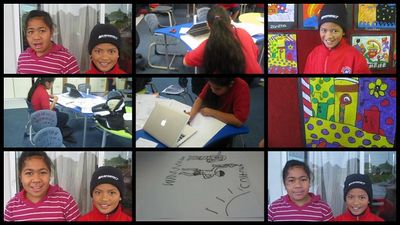 Watch the School is Cool video The brief the children were given was: The minister of education thinks that you should be solely judged on Reading, Writing, and Maths - how can you convince her otherwise? Students have also had discussions re creative commons licensing - they are fine with people learning, remixing, and have waived the non commercial clause. They would prefer that people who gain commercially are poor and not rich...
The FingerOne of our students badly damaged her finger in a door at school. This provided an authentic opportunity to create something special for the injured student. It was the last week of term so the students had the opportunity do some intensive MIE movie making. Note the soundtrack levels going up and down. I asked them how they did it. They looked at me sympathetically and said, "uh, ducking..."The point I am trying to make here is not so much about the content of the film, but that the skills that the students have acquired in movie editing have been achieved with minimal instruction. They have used trial and error to learn basic editing skills. They found Ducking through curiosity - they liked the sound of it so they applied it to see what it did. Then when they had an opportunity to use it - they remembered where it was and how it worked. It is also important to mention that this discovery took place in a group of 3-4 students. It was the conversation of "what's that for?" "I dunno try it..." "What did it do?" that enabled this real learning to take place. when they got better than me
From Oral Language to Written Language
In addition to this, we have had some MIE success using the adapted Granny cloud by way of Google Docs and WallWisher. The children in Geelong were learning about culture. My class has an extremely rich cultural mix (NZ Maori, Cook Island Maori, Tongan, Samoan, and Nuiean). We did not formally teach our children how to use the google doc. Instead we spent time talking about the more deeper issues (appropriate online behaviour etc) and then let them go for it. The children first discussed the usual themes (food, religion, clothes, jewellery etc). Then for some reason one of my students very briefly referred to a Cook Island legend. The children from Geelong asked a couple of questions about it. The student couldn't remember all of the details from the story, but other children from the Cook Islands could remember parts of it. They looked for it on the Internet but found nothing (with the exception of a performed dance of the legend at a polyfest festival). This brings up an interesting point that Puti Gardiner makes (she uses Te Reo Maori as an example). Is digital technology culturally neutral? Her children came across the same phenomena when they googled Maori Technology the results that they received were of traditional fishing tools, waka, and weaving and there was very little information on Maori and the use of contemporary technology. After discussing this with her kids they decided to start making digital stories, films, blogging and wikiing, therefore contributing their contemporary stories to the digital world. It seems that in this digital age, it is essential that a digital footprint is created so that language, stories, and culture can be sustained. Why is it not so easy to find my student's stories on the web, when finding European stories (contemporary and Traditional) is so easy? Who is responsible for rectifying this? Can I encourage my students to contribute their stories and narratives while maintaining their integrity? Is this okay? My kids talked about how their stories are shared orally to them. This is often through their Grandparents and that is how stories are passed on throughout their culture. There are, of course, variations to each story depending on whose Grandparents version we listen to. The story that was referred to, for example, had many variations within my classroom where debates raged about whether or not the main character wore the skin of a goat and so on. The use of a shared google doc was brilliant for this phenomenon. The flexibility and collaborative nature of it allows multiple perspectives to come through. When my children come back to school with the varied versions of the same story from their Grandmas, we were be able to see these differing points of view and piece together common themes. The children were able to record and share their versions of the story with their Australian friends who were then able to draw their own conclusions (given that they had observed the drafting and sharing process). This example also highlights how our role as teachers are changing. Even for the areas such as reading and writing. I am no longer selecting writing topics and providing stationery. I am working 24/7 to provide authentic and interactive audiences. Studying cultures is not confined to generalist books but providing learners with opportunities to collaborate with other learners from around the world. edit
MIE - Making connections with Elwyn RichardsonElwyn Richardson Another good influence and believer of authentic and non-standardized education introduced me to Elwyn Richardson. What I think is most striking is that the fantastic and motivating stories were written in the 1950s yet those of us using these ideas are considered to be 'innovative' and 'creative'. I am absolutely frustrated with the government's direction that is leading us away from Richardson's blissful, honest and authentic pedagogy. But, that aside, there is much to be gained from his reflections, insights, and beautiful examples of how he taught back in the day. Where Richardson used the medium of Fine Art (pottery, lino and wood cutting)to create amazing language and mathematical experiences. I have found the same experiences using video. This is not intended for me to make the bold claim that 'I am like Richardson', but that it's not about what we are teaching but how we are teaching. Where Richardson thrived in a rural environment where children observed birds and animals and harvested clay, us urbanised, suburban, (post)modernised counterparts can achieve the same. It is my intention to find these parallels to show that we can all achieve authenticity whether we are in a rural environment, purpose built 21st Century environment, or traditional cellular classroom. The point Richardson makes is not that students learn best with birds and clay but that students learn best with things that are relevant and accessible to them. One example he refers to is that his students were able to produce beautiful poetry and artworks about native birds and plants - but not from snakes. Why? They hadn't experienced snakes. This is in the same way that my students produced their best writing about how they felt about being robbed, but not so much in response to some arbitrary text in a standardised test. For those who like the sound of Richardson, try this vid for starters. edit
MIE - Where to from here?From a lecture in Bombay (May 2012) Mitra outlines his research on Remoteness, The Hole in the Wall Experiments, and the Granny Cloud. He shows how the children in his experiments were able to Self Organize their learning and reemphasizes the importance of connections and working together in groups. When Mitra talks of children learning on their own, he means in the absence of adults (not in isolation). It is crucial that children work in groups and these are often refereed to as Self Organized Learning Environments (SOLES). As stated in a previous post Mitra discusses that his research has shown that the future of education requires the following skills: Reading and Comprehension, Search and Synthesis, A system of belief. He goes on to outline his new research: If children can self-organise their learning, can they then self-learn these fundamental skills? In other words: Can children in remote areas teach themselves to read in SOLEs? This is the new and exciting next step in his research where he will be investigating this very thing. Can we open up a whole new world of opportunity for our remote learners? We can only wait and see. Sugata Mitra's full lecture here COMING SOON: ASSESSMENT! Over the next few months I will be exploring the notion of Assessment with Jo Fothergill. We will be arguing that assessment needs to be:
We will be looking specifically at children in remote areas and we will be looking at the effects that Eurocentric assessment tools and pedagogies have on our remote learners.
The Video Clips we played [3]
Other Stuff Emerging Leaders Symposium May 2011 - Tara's ELS talk here And while you are waiting watch this |
